Spectacular Images From Deep Space
Air Date: Week of July 22, 2022
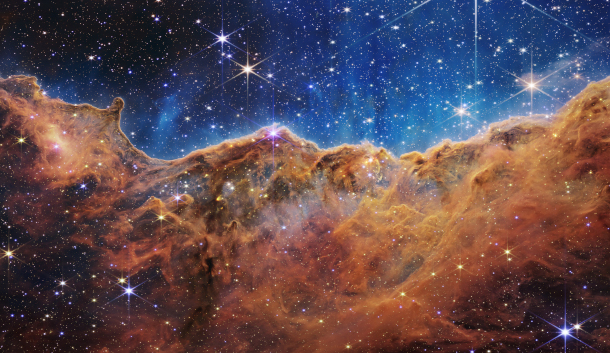
Called “the Cosmic Cliffs”, this image shows a star-forming region in the Carina Nebula. (Photo: NASA, ESA, CSA, and CTScI)
The James Webb Space Telescope is the most powerful observatory ever launched into space – and now, after six months of the mission, NASA has publicly released the telescope’s first full-color images and data. Stefanie Milam, the Deputy Project Scientist for Planetary Science at NASA, joins host Steve Curwood to give an update on the first images.
Transcript
BASCOMB: It’s Living on Earth, I’m Bobby Bascomb.
CURWOOD: And I’m Steve Curwood.
Science has yet to tell us whether we and other forms of life are alone in the universe.
Life as we know it would require a habitable planet, but it wasn’t until 1995 that science was able to confirm the existence of another planet around a star other than our sun.
It’s called Dimidium, it’s about the size of Jupiter and orbits a star in the Pegasus Constellation.
And since then science has found literally thousands more exoplanets, as they are called, and we can expect to find even more with the launch six months ago of the James Webb Space Telescope.
The James Webb is stationed a million miles away where it can look into deep space and thus way back in time.
It can also look nearby at our own solar system with unique eyes that see infrared.
NASA recently released the telescope’s first high resolution images and data, which were gathered as the scope was being commissioned into service.
Here to tell us more is Stefanie Milam.
She’s the Deputy Project Scientist for Planetary Science at NASA. Stefanie, welcome back to Living on Earth!
MILAM: Thanks for having me again.
CURWOOD: Now, the first photo that we saw that, in fact, the president of the United States was delighted to present was a deep space image. Tell us a bit about it. How far back did it look? And what observations have astronomers been able to make so far?
MILAM: I love this image. The first thing that we got to see from the James Webb Space Telescope was, of course, the SMACS 0723, or what we're calling Webb's First Deep Field. This image conveys 100% of what the James Webb Space Telescope was built and designed to do. So, we wanted to study the first stars and galaxies of the universe. So, this is just after the Big Bang, the infant universe. So, what you're seeing here is, is a galaxy field, and which is absolutely spectacular. There's a lot of peculiar things that you're seeing in the image, like some of the galaxies look like they're streaked or stretched or distorted in some way. And while the galaxies themselves aren't necessarily distorted, the light that they're emitting is actually being distorted, because there's five galaxies sort of right in the middle looks sort of like a belt going across the image, that the mass and combination of these five galaxies is actually pulling and stretching the light of the distant objects behind them and pulling them around. And so that's why they look like you know, Dalí sort of paintings, melting clock galaxies, so they're actually being lensed, in a sense. So, the same way you would imagine any other lensing to happen. So, this is something Einstein told us that was going to happen. And we were able to demonstrate that very beautifully with this image.
CURWOOD: Wait, you're saying that mass can bend light, that something we might sort of think of, generally, as a lot of gravity can bend light?
MILAM: Absolutely. So, we're basically pulling that light from those distant objects around these more massive, closer-by galaxies.
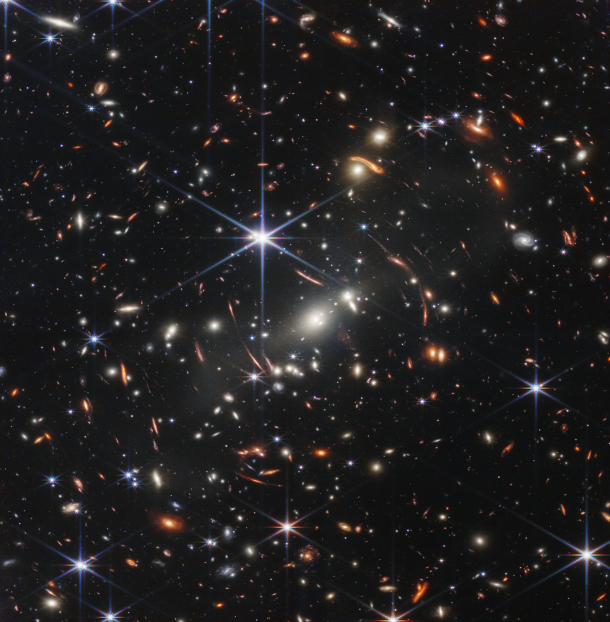
Webb’s first Deep Field is the deepest and sharpest infrared image of the universe ever captured. (Photo: NASA, ESA, CSA, and CTScI)
CURWOOD: Now, these early releases from the Webb telescope project, there were five of the four were images, but one was a spectrum analysis of the atmosphere of an exoplanet called dare I say, WASP-96b?
MILAM: Yes.
CURWOOD: Why were the spectrum data chosen to display rather than an image?
MILAM: That's an excellent question. There's a lot of detail that we actually can learn about objects that we don't resolve. Many things across the universe, even in our own solar system are point like objects, so we don't get beautiful pictures of them. But what we do get is with some of our instrumentation we have, so called spectrometers. So, what this is doing is breaking light apart into particular regions across a spectrum. And what we're looking for is the fingerprints of a given atom or a given molecule that's being sort of dispersed across that spectrum. So, say you want to look across the galaxy and understand the different regions with spectrometers. And with the resolution of the James Webb, we can actually take spectrum going across each of those galaxies, so we can study various parts. And so, with the spectrum that was released of this exoplanet, what we're seeing here is evidence of water in the atmosphere of a planet around another star.
CURWOOD: So of course, water suggests the possibility of biological activity. I mean, how excited are the astrobiologists about this?
MILAM: So, this is not necessarily water in the form that we would associate necessary for life. Most life we want something like liquid water. So that's where we come up with this phrase, the habitable zone. So, a planet has to be a certain distance from its star to not vaporize all the water, but also not freeze all the water, so the water has to maintain a certain temperature. And that's where we, we believe that liquid water could actually persist on a, on a planetary surface. And those are the types of objects that we're really interested in understanding in levels of detail that the James Webb Space Telescope is actually going to give us. The spectrum that we saw for the WASP-96b, is of a giant planet. It's a Jupiter sized planet that's extremely close to its star. And what's really cool about this planet, is it's only half the mass of Jupiter. So, it's a really puffy planet. And that whole puffy atmosphere is full of water vapor. So, it's really hot water gas, so not necessarily liquid water on the surface. But it's still a really cool finding. And it's giving us the idea and the first glimpse of the capability that James Webb Space Telescope has for studying planets around other stars. And hopefully getting to that point where we can actually see a planet that has an atmosphere with the kind of ingredients that we have in our own atmosphere. Things like carbon dioxide or methane, even water vapor is a nice telltale sign that something unique is happening on that planet.
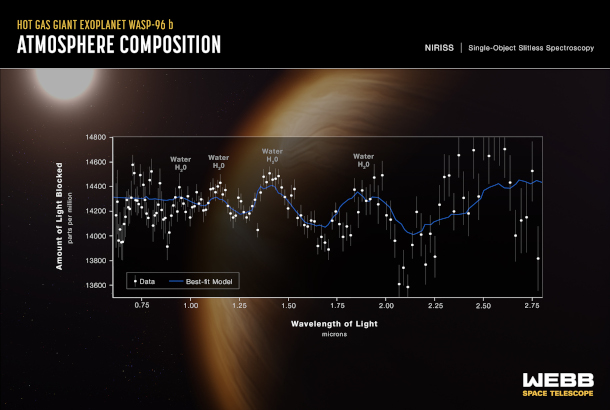
This spectrum shows the distinct signature of water vapor, along with evidence for clouds and haze, in the atmosphere of an exoplanet known as WASP-96b. (Photo: NASA, ESA, CSA, and CTScI)
CURWOOD: And, by the way, remind us how many exo-solar planets, how many exoplanets, so far has science identified? And speculate a bit as to what the James Webb Space Telescope might be able to add to that list.
MILAM: So to date, there are over 5,000 known planets around other stars. And that's just because of observational constraints: sensitivity that we have with ground-based telescopes, access to even studying these objects in any kind of detail. We have fantastic surveys up in orbit right now, including things like the TESS Mission, which is actually designed to stare at stars and huge fields across the galaxy, and see whether or not they're twinkling in the right way, suggesting that there's planets going in front of them. So, every time they get a nice suggestion of something like that happening, that's when we do follow up observations and verify whether or not it's a planet itself. So, we are reaching this era of really having a nice list of objects that we want to do some follow up studies, especially with the James Webb Space Telescope, and its capability to study the atmospheric composition of these planets. We're probably not going to be observing all 5,000 of them, and they're discovering more and more every single day. So, what we're hoping to do is get sort of a shorter list of objects that are either in this habitable zone or things that we think are peculiar in general. Maybe it's just a planet that we think is unique, and maybe has some suggestion of a process that's happening within the atmosphere that's something we want to follow up. Earth-like planets are obviously interesting. But there's also all kinds of crazy planets, like look at the diversity that we have in our own solar system.
CURWOOD: You can tell me, I mean, nobody's listening. Have you found Tatooine yet?
MILAM: We have not.
CURWOOD: I mean, this seems even bigger than science fiction, what's going on right now. I mean, people who made the movie series Star Wars, didn't have any of this tech in it.
I made a tool to compare Webb's new images to Hubble! https://t.co/1JqTxabgGC#JamesWebbSpaceTelescope pic.twitter.com/2wRO8t0LXD
— John Christensen (@JohnnyC1423) July 12, 2022
MILAM: Absolutely. This is sort of breaking that realm and blurring now what we have in science versus science fiction. We're in a whole new era of astronomy, astrophysics and planetary science, where now we're able to know that, oh, a planet around another star has clouds and weather the same way that we do on Earth, or that Jupiter has, for example. These are crazy levels of detail, that it's really hard for me to fathom how we can do this so well.
CURWOOD: Now, Stefanie, of all the images and data that has been released to the public so far, what has stood out the most to you?
MILAM: The Carina Nebula. So, we have this fantastic image that was released of what looks like a mountainous gas dust mess with stars sprinkled on top. This nebula in this image, and the spectra, actually, from this image are mind blowing. The amount of information contained in this tiny region of this entire star forming region itself. If you look at the full Carina Nebula images from the Hubble Space Telescope, we're looking at a tiny little edge of one of the bubbles in this image. And the resolution, again, all the detail if you, and I highly encourage everybody to do it, download the full resolution image and start just zooming in. Every time you zoom in, you see something different, something new, a different kind of detail: a color, an enhancement, something fluffy, something rigid, something that looks like a star, something that looks like a galaxy. There is a crazy amount of information in this and already just with our initial inspection. We already have questions in this image that we don't have answers for. And I guarantee the science return that's going to come from something just a simple glimpse in the sky is going to be just rewriting the textbooks
CURWOOD: Rewriting the textbooks, huh? Is there one of these things that you've noticed that you can explain to me what the puzzle is?
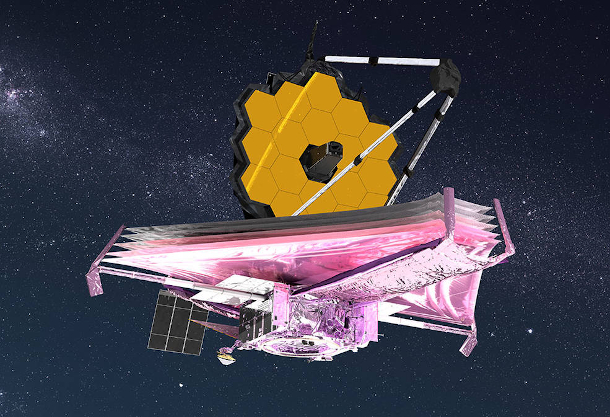
An artist’s rendering of the James Webb Space Telescope, with the multilayered sunshield stretched out beneath the observatory’s honeycomb mirror. (Photo: Adriana Manrique Gutierrez, NASA, Public Domain)
MILAM: So, there's a lot of complexity with star formation that we haven't been able to understand or know just because we haven't had the sensitivity and capability to really peer inside these clouds. We are no longer using the Hubble telescope and seeing visible light the way our own eyes see it. We're now pushed over into the infrared region. So now we have night vision goggles when we look at these objects, and we can actually see inside the clouds and the gas and the dust and we can understand what's going on inside of that cloud. That's something we haven't been able to do in a whole lot of detail just because of the sensitivity and capability of other telescopes. So just this first image alone, we're seeing all kinds of new stars being formed. There are new stars actually in the dark region on the top part of this image that have already eaten away all of their nearby gas and dust. And so that's why you have this nice sort of rigid structure at the top of the image that creates this mountainous look. But the new baby stars that are just starting to get formed are within that cloud, within that dust and gas. And when we go to longer wavelengths, using the mid-infrared instrument of the James Webb, they light up. They're like little red flecks of glitter all across that cloud of gas and dust. And those are the brand-new stars that are just starting to form. And understanding that process, how big the stars are, what's constraining the size of how big a star is, when it forms. How much material do they need to actually start forming their planetary systems, which we now know are pretty much ubiquitous across the universe. Almost every time we look at a star, we find a planet now. And we believe that not only do they have one planet, but all of them probably have multiple planets. So, it's just a phenomenon that we're just starting to get insight into. And I think the James Webb Space Telescope is really going to be the tool that really tells us about star formation.
CURWOOD: So, the James Webb Space Telescope has been in operation for about six months at the time we're speaking. How long does it take to process the images that we're seeing? And what does that look like?
Hey @NASASolarSystem, ready for your close-up? As part of Webb’s prep for science, we tested how the telescope tracks solar system objects like Jupiter. Webb worked better than expected, and even caught Jupiter’s moon Europa: https://t.co/zNHc724h9X pic.twitter.com/tW9AT5ah6T
— NASA Webb Telescope (@NASAWebb) July 14, 2022
MILAM: That is an absolutely fantastic question. And this is where I'm getting really, really nervous and anxious as we start getting James Webb Space Telescope science data down. All of these images that you've seen, were all observed and collected within the last few weeks of time. So, we started around mid-June. They're not the only things that we were doing with the telescope at that time, we just kind of squeezed in getting these images, sort of in the background as we were doing the rest of our commissioning activities. These are just blinks of an eye. These are very short periods of time to actually collect these data. Once that data is down on the ground, we have an automated process to put all of that information into something that a scientist can take, analyze very quickly, and interpret and publish. The amount of time that, considering that we just observed these objects a few weeks ago, and we already have them in a high-quality image that has been released to the public, with levels of detail and analysis already revealing new phenomenon, new science, new questions, with just this blink of an eye of the James Webb Space Telescope has been absolutely mind blowing. An exoplanet spectrum that's usually acquired takes months and months for a standard facility to do a full detailed analysis, to calibrate things. And we were able to turn this data around within a matter of weeks. This is an absolutely exceptional facility. And the team that has put together the whole data pipeline from delivering the data from the telescope to having it in your hands has just done tremendous amounts of work to ensure that this is going to be a very rapid process. And it has to be. This is so much information. This is so much data. There's no way we have enough time to ever analyze everything. It's very intimidating, but also extremely exciting.
CURWOOD: Sounds like we need more people in this kind of science.
MILAM: Absolutely. And now we have a 20-year mission. You're seeing two weeks’ worth of data, and all of the amount of information that's contained within these five images. Just imagine how much we're going to have after our first month, after the first year.
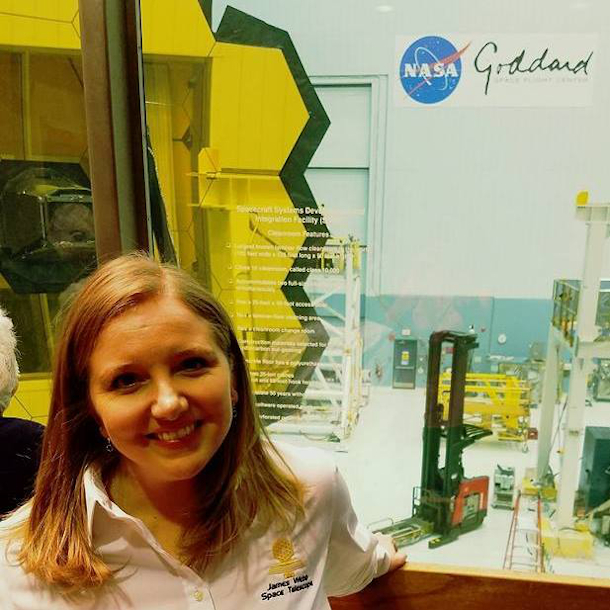
Stefanie Milam, outside the cleanroom where the James Webb Space Telescope resided. (Photo: Courtesy of Stefanie Milam)
CURWOOD: Now, in addition to the first five formal science, images and spectra, NASA has also released a couple of images of our nearby planet, I mean, comparatively, Jupiter taken during tests for the telescope. What do those images tell us now?
MILAM: So, I am the planetary scientist that's working on the James Webb Space Telescope project. So, we actually were able to do some commissioning tests on solar system objects. So, there's a number of things that we had to do to make sure that the observatory could actually observe things in our solar system. Planets, comets, asteroids, all these things move with respect to their background stars. And so, we have to make sure this giant floppy telescope that's designed to see the first galaxies of the universe can now fly across the sky and track a comet when it's coming into the inner solar system. But we also have extremely bright objects. We have the brightest thing in the infrared sky in our solar system, and that's Mars. So, we have to make sure we can actually observe these types of objects, including Jupiter and Saturn, Uranus and Neptune. And so, part of our commissioning activity was to make sure that we could do these types of observations. Mostly because they're so big and they're so bright, that light floods the entire instrument field of view. So, all of our science instruments see that light whenever a giant planet is anywhere near it. So, we had to understand how we could actually do observations of things like Europa, or pick your favorite Jupiter satellite, or pick your favorite Saturn satellite, Titan. All of these things have to be observed with the James Webb Space Telescope. So, the images that you saw from Jupiter were actually part of those tests to understand what that light actually looks like. When we saw these images come through, myself and my team, we just sat there in awe for a moment. And you know, of course, it's the solar system object that almost every major NASA observatory has used as their first image release. And here we are, just mind blown all over again. We've imaged Jupiter at near infrared wavelengths and mid infrared wavelengths and optical wavelengths. But every time you look at it with a new instrument, with a new telescope, something is revealed. And the most surprising thing that I saw in these images was that you can actually see Jupiter's rings. That is a very hard thing to do with an optical telescope of any kind. So, James Webb Space Telescope is opening up a whole new realm for planetary science as well.

Stefanie Milam is NASA’s Deputy Project Scientist for Planetary Science for the James Webb Space Telescope. (Photo: Courtesy of Stefanie Milam)
CURWOOD: So Stefanie, what can we expect now these first images have been released? I mean, how often are we going to get to see more photos, as you talked about the many years ahead, but kind of what's next?
MILAM: Well, we've started science, and there's a handful of programs, that data becomes public immediately to sort of have this rolling opportunity of sharing the amount of information, the images, the spectra that we're collecting with this fantastic observatory. Standard observing programs give the scientists that submitted that program, about a year's worth of time to work with the data before it becomes public. So, we didn't want to sort of lock everything up in this year full of secrecy with the scientists, we wanted to have something that we were able to give out to the community, let the public see what we're doing and the amazing capability of this observatory, beyond these initial images. I'm really hoping we move towards something like having an image of the month or something fun like that, just so we can keep everybody informed and engaged. But once the scientists start getting their hands on their data, they'll start publishing in very timely ways. So, stay tuned.
CURWOOD: Stefanie Milam is the deputy project scientist for planetary science for the James Webb Space Telescope. Dr. Milam, thank you so much for joining us today.
MILAM: Thank you so much for having me again, and I hope you have a great one.
Links
Click here for our previous coverage of the JWST
Read more on the James Webb Space Telescope at the official NASA site
Stefanie Milam’s biography page
Living on Earth wants to hear from you!
Living on Earth
62 Calef Highway, Suite 212
Lee, NH 03861
Telephone: 617-287-4121
E-mail: comments@loe.org
Newsletter [Click here]
Donate to Living on Earth!
Living on Earth is an independent media program and relies entirely on contributions from listeners and institutions supporting public service. Please donate now to preserve an independent environmental voice.
NewsletterLiving on Earth offers a weekly delivery of the show's rundown to your mailbox. Sign up for our newsletter today!
 Sailors For The Sea: Be the change you want to sea.
Sailors For The Sea: Be the change you want to sea.
 The Grantham Foundation for the Protection of the Environment: Committed to protecting and improving the health of the global environment.
The Grantham Foundation for the Protection of the Environment: Committed to protecting and improving the health of the global environment.
 Contribute to Living on Earth and receive, as our gift to you, an archival print of one of Mark Seth Lender's extraordinary wildlife photographs. Follow the link to see Mark's current collection of photographs.
Contribute to Living on Earth and receive, as our gift to you, an archival print of one of Mark Seth Lender's extraordinary wildlife photographs. Follow the link to see Mark's current collection of photographs.
 Buy a signed copy of Mark Seth Lender's book Smeagull the Seagull & support Living on Earth
Buy a signed copy of Mark Seth Lender's book Smeagull the Seagull & support Living on Earth

